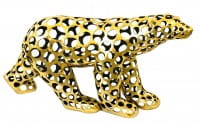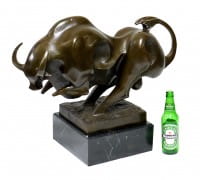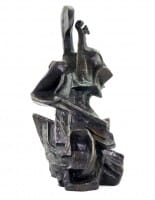Sculptures
Sculpture is one of the oldest forms of art, with roots that trace back to prehistoric times. It involves the creation of three-dimensional forms, usually in the round (viewable from all angles) or in relief (protruding from a background), and it can be additive (material is added, as in modeling or assembling) or subtractive (material is removed, as in carving).
Sculptures can be created from a wide variety of materials, including stone, metal, wood, clay, glass, ice, and even found or recycled objects. The choice of material often depends on the desired aesthetic effect, the artist's skills and preferences, and practical considerations like durability and cost.
Historically, sculptures played important roles in religious, civic, and decorative contexts. Many ancient civilizations, including the Egyptians, Greeks, and Romans, produced monumental sculptures that served religious or commemorative purposes. In the Middle Ages, sculptures were integral parts of church architecture, often conveying religious narratives. The Renaissance saw a renewed interest in freestanding, life-like sculptures inspired by ancient models.
Modern and contemporary sculpture has expanded the definition and possibilities of the medium. Abstract sculpture, which does not represent specific objects or people, became prominent in the 20th century, with artists like Henry Moore and Barbara Hepworth leading the way. Kinetic sculpture, which moves with the wind or motor power, is another modern innovation.
Conceptual artists have also used sculpture to explore ideas and concepts rather than focusing purely on aesthetics. For example, Marcel Duchamp's readymades involve the selection and re-contextualization of ordinary objects as art. In the realm of contemporary sculpture, installation art often blurs the line between sculpture and other art forms, incorporating elements such as lighting, sound, and performance.
In summary, sculpture is a diverse and evolving art form that encompasses a wide range of styles, materials, techniques, and purposes. From ancient stone carvings to cutting-edge installations, the history of sculpture reflects the endless human capacity for creative expression in three dimensions.
There are numerous famous artists known for their remarkable contributions to the field of sculpture. Here are some of the most notable ones:
- Michelangelo Buonarroti - An Italian Renaissance artist, Michelangelo is perhaps best known for his marble sculpture of "David" and his Pieta in St. Peter's Basilica, Vatican City. He masterfully depicted the human form with a balance of realistic detail and idealized beauty.
- Auguste Rodin - Often regarded as the father of modern sculpture, the French artist Rodin created expressive works that conveyed emotion and individual character. His most famous works include "The Thinker," "The Kiss," and "The Gates of Hell."
- Donatello - Another influential Italian Renaissance sculptor, Donatello is known for his work in bronze. His statue of David is the first known life-size, free-standing nude in bronze since ancient times, marking a return of the lost classical tradition.
- Henry Moore - An English artist known for his semi-abstract monumental bronze sculptures which are located around the world as public works of art. His forms are usually abstractions of the human figure, typically depicting mother-and-child or reclining figures.
- Constantin Brâncuși - A Romanian sculptor who made his career in France, Brâncuși is considered a pioneer of modernism. His sculptures often depict clean geometrical lines that form elegant representations of wildlife and portraiture, such as "The Endless Column" and "Sleeping Muse."
- Louise Bourgeois - Known for her large-scale sculpture and installation art, Bourgeois was a French-American artist. Her works, such as the towering "Maman" spider sculpture, often encompassed themes of domesticity, family, and her own childhood.
- Alexander Calder - An American sculptor known as the originator of the mobile, a type of kinetic sculpture made with delicately balanced or suspended components that move in response to motor power or air currents.
- Barbara Hepworth - An English artist and sculptor, Hepworth was a leading figure in the international art scene throughout the mid-20th century. Her work exemplifies Modernism and in particular modern sculpture.
These artists have made significant contributions to the development of sculpture as an art form, each introducing new techniques, materials, or concepts that expanded the boundaries of what sculpture could be.


















































